This homemade Canadian bacon made of cured pork loin with mild maple and sage flavours eclipses any commercially available Canadian bacon I’ve ever had in my entire life.
It’s no secret that my house is a big fan of meat in general and pork specifically. Within the subset of pork, bacon of all sorts makes my guys sing with joy.
When I made homemade bacon a handful of weeks back, one of my kids walked by happily munching a strip of crispy bacon wondering aloud, “I wonder if mom could make Canadian bacon, eh?”
They followed up that statement with a quick, “That was a Canadian ‘eh’, not a Michigan one.” and then some manic giggling. Glad to see my kids are working on their regional accents.
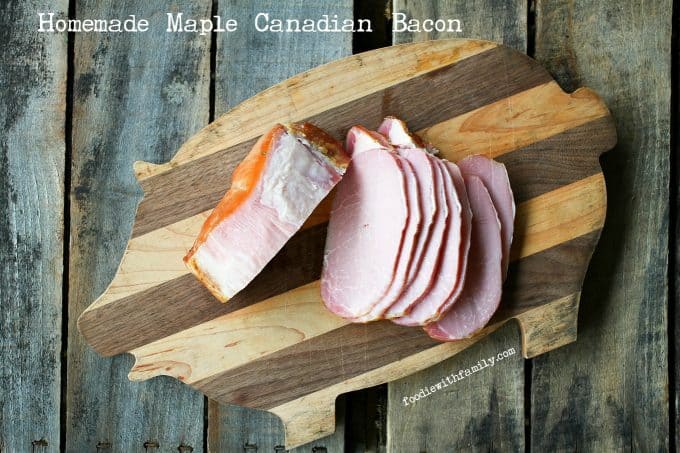
That challenge, even though it wasn’t directly delivered to me, got me to thinking. If I could make regular old American bacon, why in the world couldn’t I make some fabulous North-of-the-border bacon?
Canadian Bacon is a many splendored thing. Because it’s so lean, you really only need to heat it through rather than fry it up like our beloved American bacon making it a faster, more convenient breakfast on-the-go option.
And honestly, it’s not even really Canadian. The Canadians make pea meal bacon.
You wanna know what’s nuts? How ridiculously easy MAKING Canadian bacon is.
Mercy, though, the ease with which this is prepared pales in comparison to how insanely delicious the end product is. Cured pork loin with mild maple and sage flavours eclipses any commercially available Canadian bacon I’ve ever had in my entire life.
My unofficially official taste-testing panel of my husband and sons agreed completely. In fact, this Canadian bacon has been added to not one, not two, but THREE birthday meal requests!
What Is Canadian Bacon
The perfect Canadian bacon starts with a good chunk of readily available boneless pork loin. I’m not talking about pork tenderloins, I’m talking about center cut, lean pork loin.
Many grocers sell this in a vacuum sealed package in large amounts. This recipe makes enough brine for 4 pounds of loin, but you can upsize the brine if you get a monstrous huge loin, eh? (And I’m sorry, but that really was more of a Michigan ‘eh’ than a Canadian one…)
I feel obliged to make Canadian bacon pretty Canadian so I added a goodly slug of Grade B dark maple syrup to the brine. It gives it that something special!
If you can’t get the dark Grade B, go for a good A. The darker the syrup, the stronger the maple flavour!
If you can’t get maple syrup at all, feel free to sub in our brown sugar homemade pancake syrup. The result will be delicious if different.
Fresh sage is where it’s at, folks. Grab a bundle from the grocery store, or a handful from your neighbor’s garden (with their permission, of course!) but do splurge on the fresh sage.
And hot on the heels of my fresh sage argument, I’m going to tell you that dried whole leaf thyme is a-okay here! Fresh thyme is nice, but not quite as crucial to the finished product as the fresh sage.
Before dunking the pork loin into the brine, trim as much fat off as you can. You don’t need to be surgical, as it will be easier to remove from the Canadian Bacon AFTER it’s smoked or cooked in the oven. You can reserve the cured, smoked or roasted fat to render and add to beans.
I prefer to cut the pork loin to pieces that are a size that fit comfortably into a gallon freezer bag so they stay submerged in the brine like good little bacon.
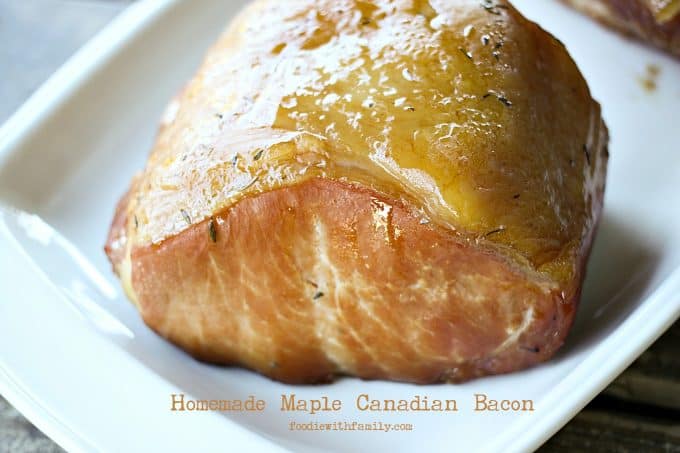
Smoking the brined Canadian Bacon over applewood is FABULOUS and preferable, but if you have no access to a smoker, you can put it in a very low temperature oven (with a little smoke box if you own one!) until the internal temperature reaches 150°F. I’ve included instructions for both methods in the recipe.
This keeps in the refrigerator for up to 10 days (courtesy of the pink salt used in the brine) but keeps far longer if tightly wrapped and stashed in the freezer.
Speaking of pink salt. I did choose to use it here.
I adapted my recipe from Michael Ruhlman’s “Charcuterie” and he makes a pretty powerful argument in favour of its use. If you choose to omit this, understand that it will shorten the shelf life in the refrigerator as well as alter the colour to more of a brown than a pink.
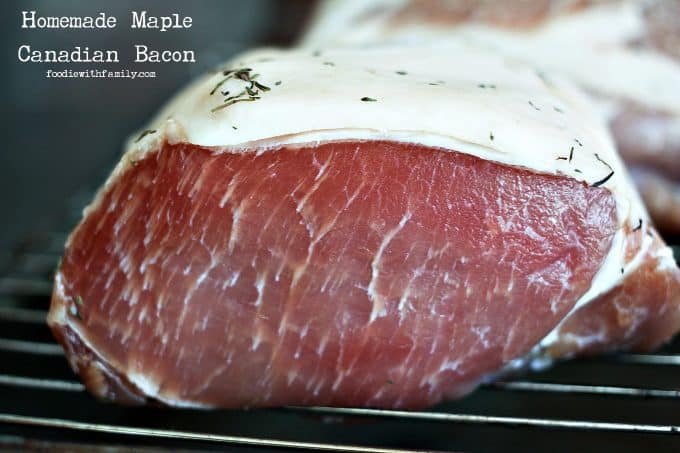
It also increases the risk of bacterial growth in the meat. Please note this means curing powder pink salts not Himalayan. The technical term for this is Prague Powder #1.
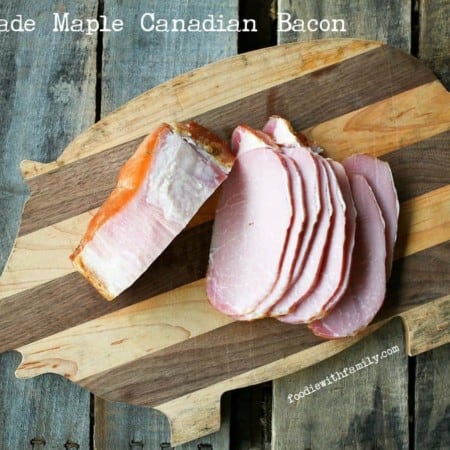
Homemade Maple Canadian Bacon {Smoker Optional}
Rate RecipeIngredients
- 1 gallon water 4 liters
- 1 1/2 cups Morton’s kosher salt 350 grams
- 1 cup raw sugar 250 grams
- 8 teaspoons pink salt 42 grams
- 1 cup Grade B Dark Maple Syrup 236 ml
- 1 bunch fresh sage
- 1 tablespoon dried thyme
- 2 garlic cloves peeled and smacked with the side of a knife to lightly crush
- 4 pounds boneless pork loin excess fat removed
Instructions
- Combine the water, salt, sugar, pink salt, maple syrup, sage, thyme, and garlic cloves in a stockpot. Bring to a simmer and stir to dissolve the sugar and salt. Remove from the heat and refrigerate until chilled all the way through. Trim the pork loin down to fit into two or more gallon sized resealable freezer bags. Insert the pork loin in the bags, then pour the cooled brine into the bags to cover the loins. Squeeze as much air as possible from the bags, then place the filled bags in a high-sided roasting pan and place the pan in the refrigerator for 72 hours.
- After 72 hours, drain the brine, rinse the pork loins, and place on a rack over a baking sheet. Put that back into the refrigerator for 24 hours to air dry.
To Smoke the Canadian Bacon:
- Hot smoke at 200°F over applewood chips for 2 to 3 hours, according to your smoker manufacturer’s instructions, or until the internal temperature of the pork loin reaches 150°F.
To Roast the Canadian Bacon:
- Preheat your oven to 200°F. Take the air-dried pork loin and put it in the oven still on its rack over its pan, and cook until the internal temperature reaches 150°F.
- Trim any remaining excess fat, then allow to cool to room temperature. Wrap the pork tightly and refrigerate for up to 10 days or wrap in a double layer of plastic wrap then a layer of foil and freeze for up to 6 months.
Nutrition
Nutritional information is an estimate and provided to you as a courtesy. You should calculate the nutritional information with the actual ingredients used in your recipe using your preferred nutrition calculator.
did you make this recipe?
Make sure to tag @foodiewithfam on Instagram and #hashtag it #foodiewithfamily so I can check it out!
Need a little help finding some Pink Salts for curing your meat? Here’s a handy-dandy Amazon affiliate link to some Prime eligible Pink Salt!
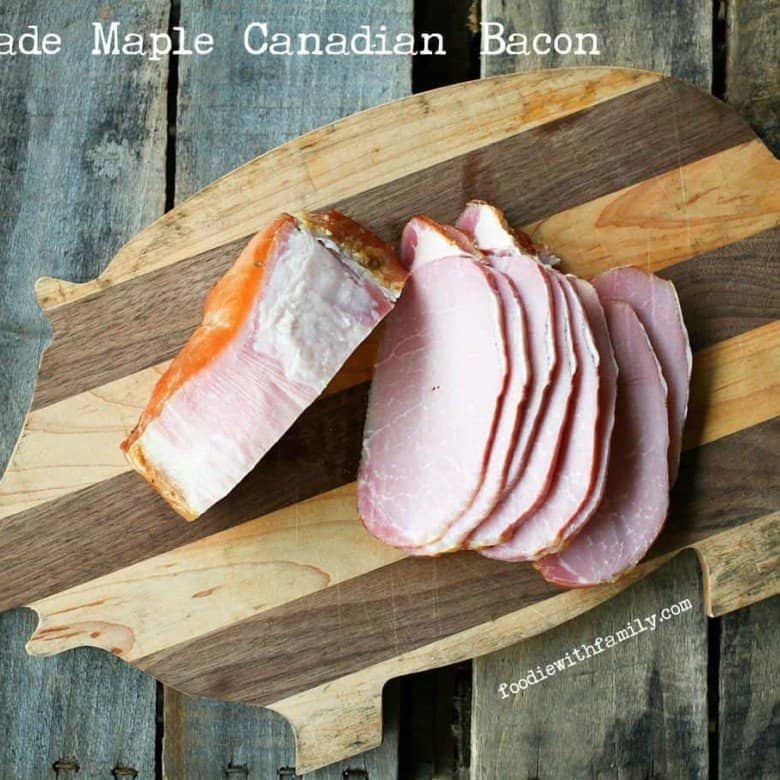



Reader's Thoughts...
Dave says
Heavy sodium % Is it possible to make a low sodium version?
Rebecca says
Hi Dave- Probably? But it’ll have a shorter life and I do not have a recommendation for how to reduce the sodium.
Lisa says
We have been making this and LOVE IT . but the more reading i do, the more i see Pink salt is not needed for hot smoked meats.. also, where did you get your mesaurments for pink salt for the amount of liquid? I would love to see a chart or calculator for making wet brine cures and how much of the Pink salt to use.
thanks
Rebecca says
Hi Lisa- My authorities on this are Chefs Michael Ruhlman and Brian Polcyn from the book Charcuterie. I trust them. 🙂
Ned Thomas Hughes says
Looks good
DanH says
The pink salt should be added after simmering and cooling not before. Heat activates the pink salt and you don’t want to do that until you smoke the meat!
Brad Smith says
I actually made this and followed the directions exactly, even smoked it. This Canadian bacon is so good!
Rebecca says
I’m so glad, Brad! Good stuff and so easy, right?
Brad Smith says
Super easy. So easy that I made another batch for my coworkers and they loved it too.
Jason Bryenton says
Ok. Do you leave the cured pork uncovered for those 24 hours in the fridge or cover?
Rebecca says
Hi Jason- It is intentionally left uncovered on a rack over a rimmed sheet pan to allow it to air dry. This helps it absorb the smoke when placed in the smoker. 🙂 Happy Bacon-Making!
Ted Robinson says
Enjoy your website.
Please will you publish a recipe for ENGLISH BACON RIBS that are brined but NOT SMOKED
Mitch Brink says
I ended up with salty roasted pork loin.
Very disappointing.
Rebecca says
Without being there, Mitch, it’s a little hard to know what went wrong. But that you’re describing it as salty makes me wonder if you used a different kind of salt from pink salt when making the brine…
Sahron says
Hello Rebecca,
Thank you for sharing your recipe. Our whole family love bacon, preferably with less fat. I am going to try this. May I ask can you cook this in the instant pot. Finish it off in the oven.
Rebecca says
Hi Sahron- I do not think this would work well in the instant pot. I prefer the low dry heat in the oven for the initial cooking process, I think. That said, if you try it in the IP, please let me know how it works for you!
sharon says
Thank you for the prompt reply. I will do as you suggested. I don’t want to spoil it. It might be just too moist. Thank you once again.:)
Gary vos says
Ive never been a big fan of Canadian bacon until now….your recipe is great…thank you….
Matt says
CLEARING UP THE PINK SALT CONTROVERSY….
I commented earlier about the massive amount of pink salt being used. Well here’s the deal. Pink salt is intended to be used in a DRY brine and rubbed onto the meat. That is what the 1oz to 25lb of meat recommendation is for. When diluting in water (wet brine) you need a LOT more pink salt to get the same concentration (parts per million). The amount of pink salt in this recipe does check out and here is where I got my information from.
https://www.meatsandsausages.com/sausage-making/curing/making-brine
Rebecca says
Thanks for coming back and clearing that up, Matt!
Adam Dunn says
Prague powder #1 is for brining and #2 is for dry cure
Paddy says
Dudette, this is beyond cool and awesome. I cure and smoke tons but this recipe is an amazing distillation of it all. Well done.
I give this to all my friends and they love me.
Cheers
ko
Walter Williams says
This is a great recipe and has become my “go to” Canadian bacon recipe.
I smoke 30 pounds every Christmas season for gifting and snacking…
It’s become a family tradition.. .
“IF” you have a smoker grab up a few blocks of your favorite cheese (mine is swiss which pairs especially well with this bacon recipe) and cold smoke some up for some great cheese, meat and cracker trays for the holidays.
Richard Ruscio says
Hi There,
A friend of mine cures, and smokes, a lot of meat, so I asked him if I could borrow the 42 grams . 8 tsp of pink salt your recipe says to use.
His labeled bottle of pink curing salt says 1 tbs per 5 pounds of meat. That’s about 1/10 th yours.
Any idea why the discrepancy?
Thanks,
rr
Rebecca says
Hey Richard- This more than one kind of pink curing salt on the market so the first step is to see whether your friend uses the same sort as I do. Other than that, my ratio is identical to that of the Canadian Bacon in Michael Ruhlman and Brian Polczyn’s book Charcuterie, so I’m pretty confident that it’s good. It’s part of a brine rather than being applied directly to the surface of the meat which means most of it is discarded.
Richard Ruscio says
Thanks. You’re for sure a sweetie !!
Robert J Weatherbee says
Can’t wait to try it
Rebecca says
It’s good stuff!! Let me know how you liked it after you try it!
Marc says
Great recipe, was wondering how I was going to cure this loin and now I know. An interesting fact regarding this Canadian bacon, I had never know what it was until I started looking for recipes to cure a pork loin and came across several talking about Canadian bacon. I just gotta say I have lived in Canada my entire life and have never had it or seen it sold, go figure Eh!
Daniel Maloney says
Thanks for the recipe however in Canada there is no such thing as Canadian bacon. It’s a USA term. We have peameal bacon and back bacon. Both are brined for up to 5 days the difference being that back bacon is lightly smoked and peameal bacon is coated in a layer of yellow cornmeal (originally ground yellow peas were used).
Patrick says
What’s your average cooking time for the oven version?
Rebecca says
Hey Patrick! You’ll just need to go by temp on that. I’d advise using a probe thermometer that you can leave in the loin while it bakes!
Joe says
This was my first time attempting making this. After seeing the recipe calling for 8 tsp of insta cure #1, I as others thought this was way too much. However, I followed the recipe exactly and I have to say this was the very best Canadian bacon I’ve ever had. My wife who usually doesn’t care for Canadian bacon exclaimed OMG!! I’ll be doing this again in the very near future and can’t wait for our relatives to visit and serve this to them. This is a great recipe. Thank you
Rebecca says
Thanks, Joe!! I agree that it’s better than any stuff I’ve ever bought! It’s so easy, too.
Ed Pollnac says
That’s a lot of Prague Powder, 8 tsp, for 4-5 pounds of meat. Can that be cut in half?
Rebecca says
Hi Ed- This is the same ratio of pink salt that Michael Ruhlman and Brian Polcyn use for their Canadian bacon in Charcuterie, so I am confident with the quantities. Please remember it’s being mixed into the brine which is then discarded vs. being stirred into the sausage as an ingredient.
Robert Clark says
People think dry cure and wet cure are the same. WET CURE IS BASED ON THE AMOUNT OF LIQUID TO BE USED WITH THE CURE.